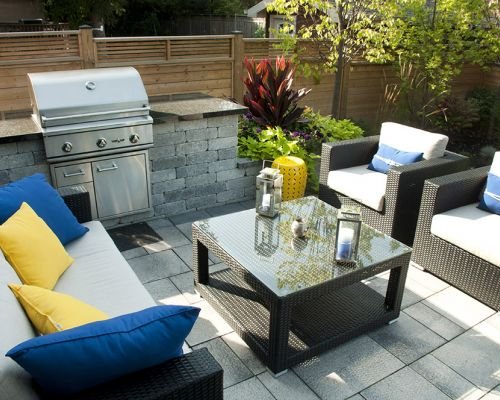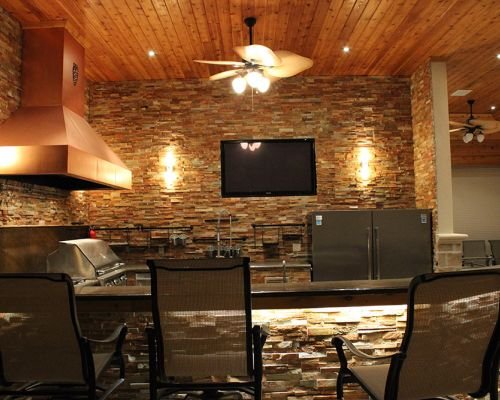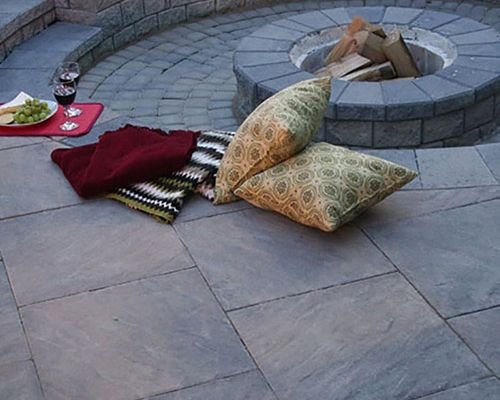Transforming Toronto yards into stunning, eco-friendly retreats is more than just planting and paving; it’s a delicate balance of beauty, sustainability, and client satisfaction. This approach champions native plants, stormwater management, and durable materials, proving that environmentally responsible design can enhance visual appeal and resilience. But how can homeowners and designers seamlessly integrate innovative features like solar lighting, water-smart technology, and recycled materials without sacrificing style? The future points toward smarter, adaptable landscapes that support biodiversity, climate resilience, and low maintenance, all while reflecting individual lifestyle values. With each project showcasing successful blends of ecological health and aesthetic allure, the question remains: Can responsible landscape design redefine outdoor living in Toronto, turning yards into lasting symbols of sustainability and beauty?
Transform Your Toronto Backyard with Expert Landscape Design
Looking to elevate your outdoor space in Toronto? Toronto Landscape & Design (TLD) specializes in creating stunning landscapes through natural stone features, water gardens, irrigation systems, and retaining walls. Our award-winning designers take everything into consideration to craft personalized backyard makeovers that blend beauty with functionality. Whether you desire a tranquil water garden or a durable retaining wall, our team ensures every detail reflects your vision. Discover how our expertise can turn your outdoor area into a breathtaking retreat. For a consultation, contact us at mike@torontolandscapedesign.com or call 1.416.644.0499. Explore the possibilities with our trusted professionals and give your Toronto home the landscape it deserves by choosing our premier backyard makeover.

Transform a Yard into an Eco-Friendly Outdoor Retreat in Toronto
Transforming a yard into an inviting outdoor retreat in Toronto involves more than just adding plants or paving a patio. It’s about striking a balance between visual appeal and environmental responsibility, creating a space that reflects the homeowner’s style while respecting the local climate. Toronto’s cold winters and humid summers require careful plant and material choices to ensure durability and longevity. Native species like black-eyed Susans or serviceberries are ideal—they thrive naturally, need less water, and require minimal maintenance, helping to reduce environmental impact without sacrificing beauty.
Designing a sustainable yard also means understanding the land’s natural features. Proper drainage, healthy soil, and sun exposure influence which plants will flourish. Incorporating eco-friendly practices such as rain gardens or permeable paving not only supports the environment but also adds visual interest. These features help manage stormwater naturally, reducing runoff and erosion while creating a cohesive, attractive outdoor space that’s both functional and inviting.
Today’s yard transformations focus on more than just looks—they aim for durability and ease of maintenance. Using eco-conscious materials for pathways, decks, and furniture ensures these elements last longer and require fewer resources over time. Thoughtful zoning, like designated relaxation zones or garden beds, keeps the space organized and minimizes clutter. This approach simplifies upkeep and helps the landscape stay vibrant and welcoming year after year.
A key part of sustainable design is balancing aesthetics with ecological health. Layered plantings add texture and color, supporting local pollinators such as bees and butterflies. Thoughtful placement of natural elements and lighting enhances visual appeal without disrupting the environment. The goal is to craft an outdoor retreat that’s both beautiful and supportive of surrounding ecosystems, providing a peaceful haven for homeowners and wildlife alike.
Achieving this seamless blend of beauty and sustainability requires careful listening to client preferences. Whether they envision a lush garden, a sleek modern patio, or a tranquil escape, the design process translates those desires into eco-conscious choices. From water-efficient irrigation to native plants and sustainable materials, every element is selected to reflect the homeowner’s lifestyle and values, ensuring the final space feels personal and responsible.
By embracing these principles, landscape professionals can create outdoor spaces that stand the test of time. Combining native plants, eco-friendly materials, and stormwater management techniques results in yards that are resilient, easy to care for, and visually stunning. This approach proves that a beautiful yard doesn’t have to come at the environment’s expense. Instead, it becomes a reflection of thoughtful, responsible design that enhances outdoor living and preserves Toronto’s natural landscape.
Core Principles that Drive Sustainable Landscape Success
Core principles of sustainable landscape design focus on creating outdoor spaces that are both visually appealing and environmentally responsible. Central to this approach is the selection of native plants, which are naturally adapted to Toronto’s climate. These species require less water, fertilizers, and chemicals, making them easier to maintain and more beneficial to local ecosystems. By prioritizing native flora, designers reduce resource consumption and foster healthier, more resilient landscapes that thrive with minimal intervention.
Effective stormwater management is another cornerstone. Incorporating features like rain gardens and permeable paving helps control runoff, prevent erosion, and recharge groundwater. Rain gardens absorb excess water during storms, reducing the risk of flooding, while permeable surfaces allow water to seep naturally into the soil. These techniques not only protect the environment but also add texture and visual interest, making the landscape both functional and beautiful.
Durability and ease of maintenance guide material choices. Using eco-friendly, long-lasting materials for pathways, decks, and furniture ensures the landscape remains vibrant over time without requiring frequent replacements or repairs. Thoughtful zoning—dedicated areas for lounging, gardening, or entertaining—keeps the yard organized and reduces clutter, simplifying ongoing upkeep. This organized design enhances the landscape’s longevity and ensures it remains inviting for years.
A balanced approach to aesthetics and ecological health shapes planting and design strategies. Layered plantings with varied textures and colors support local pollinators and boost biodiversity. Thoughtful placement of natural elements and lighting enhances visual appeal without disrupting the ecosystem. The goal is to craft outdoor spaces that are as lively and engaging as they are sustainable, encouraging a harmonious relationship between humans and nature.
Integrating client preferences into these core principles is essential. Whether a homeowner desires a lush garden, a sleek modern patio, or a peaceful retreat, the design adapts to reflect their lifestyle and values. Using water-efficient irrigation, native plants, and recycled or eco-friendly materials ensures the final landscape is personalized, functional, and responsible. This tailored approach guarantees that every project not only meets aesthetic goals but also promotes long-term sustainability.

Innovative Eco-Friendly Features Elevating Outdoor Living
Incorporating innovative, eco-friendly features can elevate a backyard into a modern retreat that seamlessly blends style with sustainability. Solar-powered lighting stands out as a sleek, energy-efficient way to illuminate pathways, highlight key garden elements, or create a cozy ambiance for evening gatherings. These lights reduce energy consumption while adding a contemporary touch that complements clean, minimalist landscape designs. Pairing them with water-smart technology, such as weather-adjusting automated irrigation systems, helps conserve water while keeping plants healthy—perfect for Toronto’s variable climate.
Features like outdoor kitchens and fire pits are increasingly popular for homeowners wanting functional yet stylish outdoor spaces. When designed with eco-conscious materials, an outdoor kitchen encourages al fresco dining and entertaining without relying heavily on energy-intensive indoor appliances. Recycled or sustainably sourced materials for fire pits and countertops add a responsible touch, creating focal points that invite gatherings and extend usability into cooler months. These elements transform the yard into a versatile space that balances luxury with ecological mindfulness.
Adding water features, such as rain gardens or small ponds, can bring tranquility while supporting local ecosystems. Rain gardens absorb stormwater runoff, reducing erosion and flooding, while small ponds attract native wildlife like birds and insects, enriching the yard’s ecological diversity. When integrated with native plantings and natural elements, these features enhance visual appeal and foster a harmonious environment that benefits both homeowners and the surrounding landscape. The result is a peaceful, vibrant outdoor retreat that feels both natural and thoughtfully designed.
Modular and adaptable outdoor elements encourage ongoing engagement and flexibility as needs evolve. Movable planters, reconfigurable seating, and multi-purpose structures allow homeowners to customize their space over time. As climate resilience becomes more critical, incorporating native and climate-adapted plants ensures the landscape remains vibrant and low-maintenance despite weather fluctuations. These adaptable features make outdoor spaces more resilient, inviting, and aligned with eco-conscious goals.
Eco-friendly materials continue to define the future of outdoor design. Reclaimed wood for decks and furniture adds warmth and character, while recycled plastics for edging or furnishings provide durability with a reduced environmental footprint. These choices demonstrate that sustainable materials can be both stylish and long-lasting, reinforcing the idea that beauty and responsibility go hand in hand. Thoughtfully integrating innovative features ensures yards are not only visually stunning but also environmentally responsible, creating outdoor retreats that stand the test of time.
Real-World Toronto Projects Showcasing Green Design Excellence
Toronto’s landscape projects showcase how thoughtful design and sustainable practices can come together to create truly inspiring outdoor spaces. One standout example transformed a small backyard into a lush oasis by using native plants that thrive naturally in Toronto’s climate. Incorporating permeable paving helped manage stormwater effectively, preventing erosion and reducing runoff, all while adding visual interest. This project demonstrates that blending eco-friendly features with aesthetic appeal results in a low-maintenance retreat that’s both inviting and environmentally responsible.
Another successful case involved integrating an outdoor kitchen and fire pit into the backyard design. The homeowner wanted a space that balanced style with functionality. By selecting eco-conscious materials and including energy-efficient lighting, the design achieved a perfect mix of luxury and sustainability. Native plants surrounding the area attracted pollinators, supporting local biodiversity, while permeable surfaces minimized environmental impact. These elements prove that modern outdoor living spaces can be both convenient and eco-friendly without sacrificing beauty.
A different project focused on creating a peaceful water feature using recycled materials. A small pond was installed with native plants to enhance tranquility and support the local ecosystem. Prioritizing durable, low-impact materials required minimal upkeep, making it a sustainable focal point. The result is a serene retreat that blends seamlessly into the landscape, proving ecological considerations can go hand in hand with visual appeal. Such features elevate the yard’s beauty while promoting ecological health.
Analyzing these projects reveals that aligning client desires with green principles leads to successful outcomes. Homeowners often envision lush gardens, sleek patios, or cozy fire pits—each of which can be realized sustainably. Using native plants, eco-friendly materials, and water-smart features makes the space easier to maintain and more resilient over time. Tailoring solutions to individual lifestyles ensures the final landscape genuinely reflects the client’s personality and values.
Partnering with suppliers who prioritize sustainability plays a crucial role. Many projects incorporate reclaimed wood for decks or furniture, reducing waste and adding character. Recycled plastics are used for edging or outdoor furnishings, offering durability without environmental harm. These choices reinforce that eco-conscious design can be both stylish and long-lasting, supporting the broader goal of creating outdoor retreats that are as responsible as they are beautiful.
Maintaining these landscapes requires a mix of regular attention and mindful care. Native plants need less watering and fewer chemicals, simplifying ongoing maintenance. Seasonal pruning, mulching, and inspections of permeable paving prevent erosion or drainage issues. Proper watering and fertilization keep plants healthy, ensuring the landscape remains vibrant and sustainable with minimal environmental impact. This steady, manageable effort allows homeowners to enjoy their outdoor space year-round without compromise.
The success of these projects demonstrates that integrating beauty, sustainability, and client satisfaction is entirely achievable. Thoughtful plant choices, eco-friendly materials, and innovative features create outdoor spaces that are both functional and visually engaging. These examples serve as proof that responsible design elevates outdoor living, turning yards into personal sanctuaries and models of environmental stewardship.
Ultimately, these case studies highlight that sustainable landscaping in Toronto doesn’t mean sacrificing aesthetic appeal. When careful planning and eco-conscious practices are combined, the result is a resilient, low-maintenance, and stunning outdoor retreat. These projects prove that with the right approach, beauty and sustainability can coexist seamlessly, enriching both the landscape and the community.

Future Trends Shaping Toronto’s Sustainable Yard Landscape
Looking ahead, the future of sustainable yard design in Toronto will be shaped by technological innovations and a deeper commitment to ecological resilience. Smart irrigation systems, which adjust watering based on real-time weather data and soil moisture levels, are becoming more accessible and reliable. These tools help homeowners conserve water while keeping their landscapes lush, making sustainable practices easier to adopt. Meanwhile, advancements in solar technology continue to transform outdoor lighting and features, with solar-powered lights, water features, and appliances offering stylish, energy-efficient options that reduce carbon footprints.
Green infrastructure is expanding into residential landscapes, with living walls, green roofs, and native plant corridors supporting better air quality and biodiversity. These features turn yards into mini-ecosystems, delivering multiple benefits—beauty, habitat, and environmental health—all in one. As climate change introduces more unpredictable weather patterns, designers are increasingly turning to native and climate-adapted plants that can withstand extremes, reducing maintenance and ensuring long-term resilience.
Modular and adaptable outdoor elements will become more common, allowing homeowners to reconfigure spaces as their needs and preferences evolve. Movable planters, reconfigurable patios, and multi-use structures encourage ongoing engagement and flexibility. These adaptable features also help landscapes better cope with changing climate conditions, supporting sustainability while maintaining visual appeal.
The rise of eco-conscious materials continues to influence design choices. Reclaimed woods, recycled plastics, and biodegradable composites are now standard options, combining durability with environmental responsibility. These materials not only reduce waste but also add unique textures and character to outdoor spaces, proving that style and sustainability can go hand in hand.
As awareness of environmental impacts grows, landscape professionals will prioritize native plantings and water-smart systems even further. Permeable pavements, rain gardens, and natural stormwater management techniques will become baseline features, helping to prevent erosion and reduce runoff. This shift supports healthier ecosystems while giving yards a more natural, inviting look.
Homeowners will increasingly expect outdoor spaces that are easy to maintain and environmentally responsible. Integrated systems—solar lighting, automated irrigation, and eco-friendly materials—will create seamless, low-impact landscapes that still feel luxurious and personalized. Design will focus on creating resilient, vibrant yards that adapt to Toronto’s changing climate without sacrificing style.
The integration of innovative, sustainable features will make outdoor retreats more than just beautiful spaces—they’ll become vital parts of a community’s environmental footprint. These yards will serve as models of how responsible design supports biodiversity, conserves resources, and enhances quality of life.
In the end, Toronto’s outdoor spaces will continue to evolve into vibrant, eco-friendly retreats that blend cutting-edge technology with native resilience. This ongoing transformation reflects a community committed to sustainability, where responsible design enriches both the landscape and the lives of those who enjoy it.